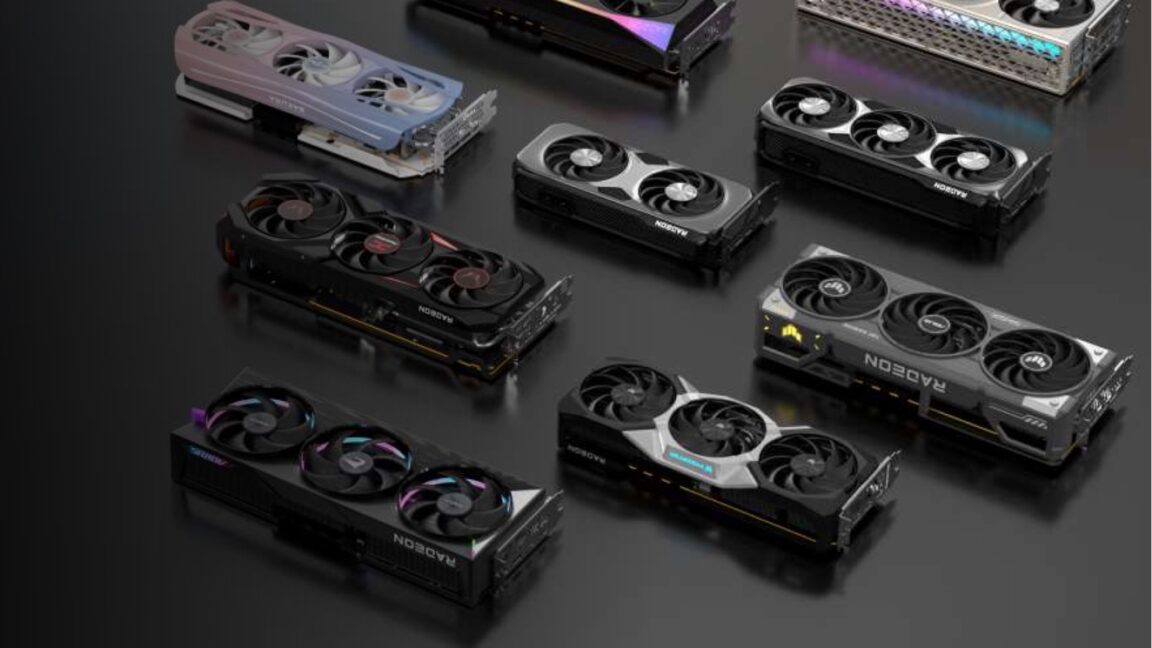
AMD promises mainstream 4K gaming with next-gen GPUs as current-gen GPU sales tank
arstechnica.com
nvidia could clearly use some competition AMD promises mainstream 4K gaming with next-gen GPUs as current-gen GPU sales tank 9070-series Radeon GPUs were announced at CES, with plans to launch in March. Andrew Cunningham Feb 5, 2025 4:28 pm | 28 AMD's RDNA 4 launch will begin with the 9070 XT and 9070, which are both being positioned as upper-midrange GPUs like the RTX 4070 series. Credit: AMD AMD's RDNA 4 launch will begin with the 9070 XT and 9070, which are both being positioned as upper-midrange GPUs like the RTX 4070 series. Credit: AMD Story textSizeSmallStandardLargeWidth *StandardWideLinksStandardOrange* Subscribers only Learn moreAMD announced its fourth-quarter earnings yesterday, and the numbers were mostly rosy: $7.7 billion in revenue and a 51 percent profit margin, compared to $6.2 billion and 47 percent a year ago. The biggest winner was the data center division, which made $3.9 billion thanks to Epyc server processors and Instinct AI accelerators, and Ryzen CPUs are also selling well, helping the company's client segment earn $2.3 billion.But if you were looking for a dark spot, you'd find it in the company's gaming division, which earned a relatively small $563 million, down 59 percent from a year ago. AMD's Lisa Su blamed this on both dedicated graphics card sales and sales from the company's "semi-custom" chips (that is, the ones created specifically for game consoles like the Xbox and PlayStation).Other data sources suggest that the response from GPU buyers to AMD's Radeon RX 7000 series, launched between late 2022 and early 2024, has been lackluster. The Steam Hardware Survey, a noisy but broadly useful barometer for GPU market share, shows no RX 7000-series models in the top 50; only two of the GPUs (the 7900 XTX and 7700 XT) are used in enough gaming PCs to be mentioned on the list at all, with the others all getting lumped into the "other" category. Jon Peddie Research recently estimated that AMD was selling roughly one dedicated GPU for every seven or eight sold by Nvidia.But hope springs eternal. Su confirmed on AMD's earnings call that the new Radeon RX 9000-series cards, announced at CES last month, would be launching in early March. The Radeon RX 9070 and 9070 XT are both aimed toward the middle of the graphics card market, and Su said that both would bring "high-quality gaming to mainstream players."An opportunity, maybe"Mainstream" could mean a lot of things. AMD's CES slide deck positioned the 9070 series alongside Nvidia's RTX 4070 Ti ($799) and 4070 Super ($599) and its own RTX 7900 XT, 7900 GRE, and 7800 XT (between $500 and $730 as of this writing), a pretty wide price spread that is still more expensive than an entire high-end console. The GPUs could still rely heavily on upscaling algorithms like AMD's Fidelity Super Resolution (FSR) to hit playable frame rates at those resolutions, rather than targeting native 4K.But the promise at least implies that AMD is confident in the value that the RX 9000-series cards are going to provide. And Nvidia's next-generation lineup suggests that AMD has its best opportunity in years to grab some attention and some market share with a fast, reasonably priced GPU.Aside from the powerful GeForce RTX 5090, none of the 50-series graphics cards that Nvidia has announced so far look like massive upgrades over the 40-series. That's especially true for the $549 GeForce RTX 5070, which comes with significantly fewer CUDA cores than last year's RTX 4070 Super. AMD has lofty but vague promises about the benefits of its RDNA 4 GPU architecture. Credit: AMD The RX 7000 series usually came in a bit cheaper than comparable Nvidia cards, but never by enough to decisively offset Nvidia-exclusive advantages like DLSS upscaling, better power efficiency, and superior performance in games with heavy ray-tracing effects. It seems as though AMD's efforts kept some of Nvidia's price increases under controlthe 4060 was a shade cheaper than the 3060, and the mid-generation refreshes of the 4070 and 4080 cards all improved their value quite a bit. But it was (apparently) never enough to make the 7000 series actually appealing to GPU buyers.The right cards at the right prices could help the Radeon RX 9000-series cards succeed where the 7000-series fell short. Of the few details we currently have about the 9070 and 9070 XT, they all seem designed to address the 7000 series' biggest deficits: A new 4 nm TSMC manufacturing process should improve power efficiency; ML-powered upscaling for AMD's Fidelity Super Resolution (FSR) 4 could help close the quality gap between FSR and DLSS; and the cards will have next-generation ray-tracing accelerators that could help with the 6000- and 7000-series cards' weak ray-tracing performance.Of course, it's also possible that the real 9070 cards aren't as good as they look on paper. Either way, we'll know more in a month or so.Andrew CunninghamSenior Technology ReporterAndrew CunninghamSenior Technology Reporter Andrew is a Senior Technology Reporter at Ars Technica, with a focus on consumer tech including computer hardware and in-depth reviews of operating systems like Windows and macOS. Andrew lives in Philadelphia and co-hosts a weekly book podcast called Overdue. 28 Comments
0 Comentários
·0 Compartilhamentos
·65 Visualizações


